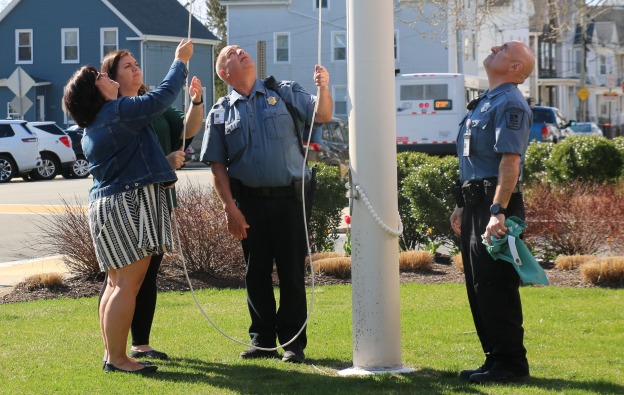 New Bedford’s Abraham Lincoln Elementary School was recognized along with five other schools in the Commonwealth for its sustainable “green” design elements. The school was one of five schools in the Commonwealth honored by the “Green Schools Organization” as a green learning environment. Mayor Mitchell presented the award to the Lincoln School today and spoke about the building’s energy efficient design features as well as efficiency measures implemented in other school buildings throughout the district.
New Bedford’s Abraham Lincoln Elementary School was recognized along with five other schools in the Commonwealth for its sustainable “green” design elements. The school was one of five schools in the Commonwealth honored by the “Green Schools Organization” as a green learning environment. Mayor Mitchell presented the award to the Lincoln School today and spoke about the building’s energy efficient design features as well as efficiency measures implemented in other school buildings throughout the district.
“This project proves that while there are many costs that government incurs that are beyond our ability to control, with just a little bit of effort, we can sharply reduce the cost of heat and electricity that we consume,” said Mayor Mitchell.
The City of New Bedford worked with Daedalus Projects Inc., MVG Architects and their consultant team to design and develop a school that provides students with a 21st Century learning environment. The 93,833 square foot elementary school serves students in kindergarten through fifth grade. It features an auditorium, gymnasium, cafeteria, library/media center, classroom spaces, and a recreation area which includes a synthetic turf field and resilient track. The facility contains high efficiency systems and meets or exceeds all Massachusetts Collaborative for High Performance Schools requirements.
The Lincoln School’s green design features include:
- Light colored membrane on roof surfaces to reduce the heat island effect.
- School is sited in a central location within close proximity to public transportation basic services, pedestrian and bike access.
- Synthetic playfield for student and public use eliminates potable water irrigation.
- Contains on-site alternative energy sources for electricity production through installation of a 80kwh Photovoltaic (PV) system on the roof.
- High efficient mechanical, electrical, and plumbing systems which exceed the MA Building Energy code by 30%; the majority of the classrooms are designed without air conditioning.
- Recycles 90% of the waste generated by the school Diverted 90% of construction and demolition waste to recycling plant in lieu of a landfill.
- Environmentally-friendly materials including recycled content, salvaged and certified wood materials were utilized.
- Classrooms are designed with access to views and natural day lighting.
- Protects students and staff health during occupancy by specifying walk-off mats, low-emitting materials, and high efficiency HVAC filters.
- Created a school maintenance plan of all equipment for preventive and maintenance needs and adopt the Anti-Idling policy to reduce emissions.
- The new school was built on the existing school site. The reuse of this site, promotes “Smart Growth” which protects undeveloped land and allows for the re-use of existing infrastructure, including: site utilities and roads.
The Abraham Lincoln School has also been designated a Model School by the Commonwealth of Massachusetts’ Model School Program. The designation allows other communities to re-use the Abraham Lincoln Elementary School design as a model for their own school buildings. Model school buildings are chosen by the MSBA for their optimal classroom space, efficiency, ease of maintenance, capacity, and their incorporation of sustainable “green” design elements.
In addition to the Lincoln School, the City maintains close to one-hundred buildings, including nearly thirty schools, and major water and wastewater facilities. Many of the municipal buildings are antiquated and are costly to heat and cool. Mayor Mitchell’s Fiscal Year 2013 City Budget includes funding for an Office of Energy Efficiency at the Department of Public Infrastructure.
The City has already implemented energy efficiency measures at several school buildings including Alfred J. Gomes Elementary, Hayden McFadden Elementary, Casmir Pulaski Elementary, Carney Academy, and Roosevelt Middle School. Such efficiency measures include:
- Upgraded lighting
- Hot water circulation pumps
- Variable frequency drives (power electronics conversion device used to control air conditioner motor)
- Motors
- Upgrades to existing energy management systems (EMS)
- Occupancy sensors
- De-stratification fans (helps equalize building’s internal temperature)
- Demand control ventilation (ventilation based on occupancy and actual activity)
- Controls on exhaust fans, air handlers, unit ventilators and zones
- Conversion from oil natural gas for heat
New Bedford’s Energy Director, Scott Durkee, estimates that efficiency measures adopted in school buildings to date have resulted in savings totaling over $400,000.00.
Mayor Mitchell added, “Being energy conscious is not just environmentally friendly, it is financially imperative. New energy conservation measures implemented by DPI’s Energy Efficiency Office when put in place today will help us hold down our property tax bills tomorrow.”
 New Bedford Guide Your Guide to New Bedford and South Coast, MA
New Bedford Guide Your Guide to New Bedford and South Coast, MA








